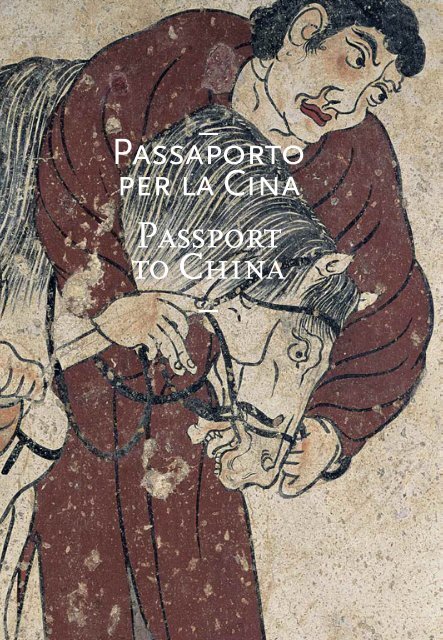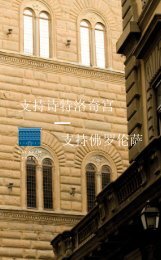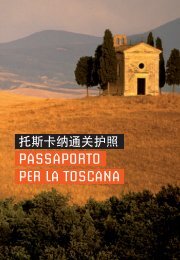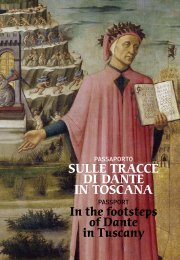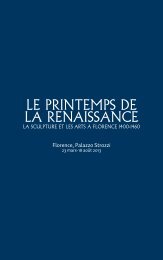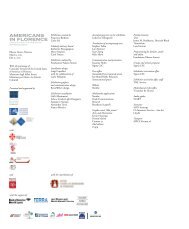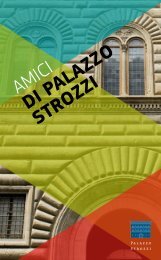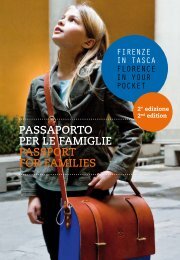_ PAssAPORTO PER LA CInA Passport to China _ - Palazzo Strozzi
_ PAssAPORTO PER LA CInA Passport to China _ - Palazzo Strozzi
_ PAssAPORTO PER LA CInA Passport to China _ - Palazzo Strozzi
Create successful ePaper yourself
Turn your PDF publications into a flip-book with our unique Google optimized e-Paper software.
_<br />
Passapor<strong>to</strong><br />
per la Cina<br />
<strong>Passport</strong><br />
<strong>to</strong> <strong>China</strong><br />
_
_<br />
Passapor<strong>to</strong><br />
per la Cina<br />
<strong>Passport</strong><br />
<strong>to</strong> <strong>China</strong><br />
_
_<br />
James M. Bradburne<br />
Diret<strong>to</strong>re Generale<br />
Fondazione <strong>Palazzo</strong> <strong>Strozzi</strong><br />
Nel 2006 il Comune, la Provincia e la Camera di Commercio di<br />
Firenze con una Associazione di partners privati ha crea<strong>to</strong> una<br />
delle prime fondazioni indipendenti pubblico-private d’Italia, la<br />
Fondazione <strong>Palazzo</strong> <strong>Strozzi</strong>. <strong>Palazzo</strong> <strong>Strozzi</strong> nasce per essere<br />
un centro vitale, dinamico e internazionale per la cultura a<br />
Firenze, ospitando grandi mostre che abbracciano un ampio<br />
ventaglio di temi.<br />
Cina: alla Corte degli Impera<strong>to</strong>ri. Capolavori mai visti dalla tradizione<br />
Han all’eleganza Tang (25-907) è una spettacolare celebrazione<br />
dell’Età d’oro cinese. Durante la dinastia Tang (618-907)<br />
si ebbe una rinascita delle arti, dell’artigiana<strong>to</strong> e della produzione<br />
letteraria, nota come momen<strong>to</strong> altissimo di quella civiltà.<br />
La dinastia Tang è fiorita grazie alla straordinaria apertura nei<br />
confronti di idee e influenze straniere. Mol<strong>to</strong> tempo prima<br />
dell’attuale età della globalizzazione, la Via della Seta rappresentò<br />
un canale per idee originali e tecnologie innovative.<br />
Passapor<strong>to</strong> per la Cina, distribui<strong>to</strong> in esclusiva in coincidenza<br />
con la mostra Cina: alla Corte degli Impera<strong>to</strong>ri, celebra le<br />
relazioni che da lunga data intercorrono tra Cina e Toscana.<br />
Dalla seta alla terracotta, dalla porcellana allo street food, usa<br />
ques<strong>to</strong> passapor<strong>to</strong> per esplorare le numerose e disparate opere<br />
d’arte e attività che, a Firenze e din<strong>to</strong>rni, parlano dell’eredità<br />
della Via della Seta!<br />
3
_<br />
James M. Bradburne<br />
Direc<strong>to</strong>r General<br />
Fondazione <strong>Palazzo</strong> <strong>Strozzi</strong><br />
In 2006 the Comune, Provincia, and Chamber of Commerce<br />
of Florence with an association of Private Partners created one<br />
of Italy's first independent public-private foundations, the<br />
Fondazione <strong>Palazzo</strong> <strong>Strozzi</strong>. <strong>Palazzo</strong> <strong>Strozzi</strong> is set <strong>to</strong> become a<br />
vital, dynamic and international centre for culture in Florence,<br />
hosting major exhibitions across a vast spectrum. <strong>China</strong>: at the<br />
Court of the Emperors. Unknown masterpieces from Han tradition<br />
<strong>to</strong> Tang elegance (25-907) is a spectacular celebration of <strong>China</strong>'s<br />
Golden Age. The Tang dynasty (618 - 907) was a renaissance<br />
of the arts, crafts and literature, recognised <strong>to</strong> be a high point<br />
of Chinese civilisation.<br />
The Tang dynasty flourished due <strong>to</strong> an extraordinary openness<br />
<strong>to</strong> foreign ideas and influences. Long before the current age of<br />
globalisation, the Silk Road was a channel for new ideas and<br />
innovative technology. <strong>Passport</strong> <strong>to</strong> <strong>China</strong>, issued exclusively <strong>to</strong><br />
coincide with the exhibition <strong>China</strong>: at the Court of the Emperors<br />
celebrates the longstanding relationship between <strong>China</strong> and<br />
Tuscany. From terracotta <strong>to</strong> porcelain, from silk <strong>to</strong> street food,<br />
use this passport <strong>to</strong> explore the vast range of activities and artworks<br />
in and around Florence that speak <strong>to</strong> the legacy of the<br />
Silk Road!<br />
4
_<br />
An<strong>to</strong>nio Nicola Preiti<br />
Diret<strong>to</strong>re Agenzia per il Turismo di Firenze<br />
La mostra Cina: alla Corte degli Impera<strong>to</strong>ri è una grande<br />
occasione per Firenze e per <strong>Palazzo</strong> <strong>Strozzi</strong>: l’occasione<br />
di mostrare al mondo cosa sa offrire una città tradizionalmente<br />
considerata chiusa in se stessa. Con questa mostra Firenze si<br />
apre alla splendida arte cinese della dinastia Tang, grazie anche<br />
alle porte ormai regolarmente spalancate e accoglienti di<br />
<strong>Palazzo</strong> <strong>Strozzi</strong>, una grande casa ospitale per la città e per<br />
i visita<strong>to</strong>ri, un conteni<strong>to</strong>re per le grandi mostre del piano nobile<br />
e per l’arte contemporanea della <strong>Strozzi</strong>na.<br />
Aprirsi significa anche aprirsi all’altro, al diverso, all’esotico:<br />
uno dei punti di forza della mostra e di tutte le attività a essa<br />
correlate è l’inten<strong>to</strong> di mostrare quan<strong>to</strong> il concet<strong>to</strong> di ‘altro da<br />
noi’ sia relativo, e che se l’arte e la cultura, come peraltro gli<br />
stili di vita e le usanze, cinesi possono sembrare esotici a occhi<br />
occidentali, l’arte, la cultura, le usanze e gli stili di vita occidentali<br />
lo sono altrettan<strong>to</strong>, se non di più, per i visita<strong>to</strong>ri cinesi. Aprirsi<br />
a quello che si potrebbe definire il relativismo della diversità è<br />
cer<strong>to</strong> uno dei modi migliori per affermare l’uguaglianza fra i<br />
popoli, in particolare oggi che lo spostamen<strong>to</strong> e la circolazione<br />
delle masse di individui, per motivi economici prima ancora<br />
che culturali e turistici, ha raggiun<strong>to</strong> dimensioni senza precedenti.<br />
Iniziative come ques<strong>to</strong> Passapor<strong>to</strong>, che offre a partire dalla<br />
mostra percorsi e chiavi di lettura di Firenze, del suo terri<strong>to</strong>rio<br />
e oltre, sono fondamentali per una promozione turistica<br />
qualificata e di assoluta contemporaneità.<br />
6
_<br />
An<strong>to</strong>nio Nicola Preiti<br />
Direc<strong>to</strong>r Agenzia per il Turismo di Firenze<br />
The exhibition <strong>China</strong>: at the Court of the Emperors is a wonderful<br />
opportunity for Florence and for <strong>Palazzo</strong> <strong>Strozzi</strong>: an opportunity<br />
<strong>to</strong> show the world what a city traditionally thought of as<br />
inward-looking can achieve. Florence is open <strong>to</strong> the splendid<br />
Chinese art of the Tang dynasty, an openness symbolised by the<br />
doors of <strong>Palazzo</strong> <strong>Strozzi</strong>, which are now regularly wide open on<br />
every side. The <strong>Palazzo</strong> welcomes Florentines and visi<strong>to</strong>rs <strong>to</strong> the<br />
heart of the city where it stages major exhibitions on the first<br />
floor, and contemporary art events in the <strong>Strozzi</strong>na.<br />
Being open also implies an attitude <strong>to</strong> others, <strong>to</strong> the different,<br />
<strong>to</strong> the exotic. One of the great strengths of the exhibition and of<br />
the related events is how clearly they show the concept of “the<br />
other” <strong>to</strong> be relative. For while Chinese art and culture, lifestyles<br />
and cus<strong>to</strong>ms, might appear exotic <strong>to</strong> western eyes the<br />
same is true, if not more so, of the Chinese perception of our<br />
world. To open up <strong>to</strong> what might be defined as the relativism of<br />
diversity is undoubtedly one of the best ways <strong>to</strong> affirm equality<br />
among peoples. This is especially true <strong>to</strong>day when the migration<br />
and movements of such large numbers of individuals,<br />
primarily for economic rather than for cultural reasons, has<br />
reached unprecedented levels.<br />
Initiatives like this <strong>Passport</strong>, taking the exhibition as the starting<br />
point for a new exploration and understanding of Florence and<br />
its surroundings, capture the contemporary spirit and are vital<br />
in promoting high-quality <strong>to</strong>urism.<br />
7
_<br />
Cina<br />
alla Corte degli Impera<strong>to</strong>ri<br />
Capolavori mai visti<br />
dalla tradizione<br />
Han all’eleganza Tang<br />
(25-907)<br />
<strong>China</strong><br />
at the Court of the Emperors<br />
Unknown masterpieces<br />
from Han tradition<br />
<strong>to</strong> Tang elegance<br />
(25-907)<br />
_
La mostra, curata da Sabrina Rastelli e con l’allestimen<strong>to</strong> di<br />
Romeo Gigli, porta per la prima volta in Europa oltre 200 capolavori<br />
che testimoniano il fas<strong>to</strong> e il cosmopolitismo delle corti<br />
imperiali dall’epoca Han (23-220) fino all’impero Tang (617-<br />
907). Perché una mostra sulla Cina a Firenze? L’èra della dinastia<br />
Tang è considerata l’Età d’oro cinese: la sua arte<br />
rappresenta uno dei vertici della s<strong>to</strong>ria culturale del Paese e il<br />
suo splendore è paragonabile a quello del Rinascimen<strong>to</strong> fiorentino.<br />
La Cina dell’epoca, affascinata da tut<strong>to</strong> ciò che era esotico,<br />
importava un’infinita varietà di merci da tut<strong>to</strong> il mondo,<br />
attraverso la Via della Seta, che collegava l’Estremo Oriente al<br />
Mediterraneo attraverso l’Asia Centrale e la Persia. Assieme alle<br />
merci, affluivano nella capitale Chang’an genti di paesi, razze e<br />
religioni diverse con le loro credenze, usanze e costumi che si<br />
diffusero nella società cinese, divenendone parte integrante.<br />
Soprattut<strong>to</strong> nell’arte, sintetizzando in maniera mirabile gli elementi<br />
nuovi, si venne a creare un linguaggio fra i più significativi<br />
e innovativi nella s<strong>to</strong>ria della Cina. Splendidi affreschi,<br />
spettacolari sculture di pietra, squisiti manufatti d’oro e d’argen<strong>to</strong>,<br />
raffinatissimi gioielli, vivaci statue di terracotta e vetri<br />
esotici ci conducono alla scoperta di ques<strong>to</strong> nuovo linguaggio.<br />
Firenze, <strong>Palazzo</strong> <strong>Strozzi</strong><br />
piazza <strong>Strozzi</strong><br />
7 marzo - 8 giugno 2008<br />
www.cinamaivistafirenze.it<br />
Orario mostra<br />
tutti i giorni 9.00-20.00<br />
Giovedì ore 9.00-23.00<br />
Info in mostra<br />
T. +39 055 2645155<br />
11<br />
Prenotazioni<br />
Sigma CSC<br />
T. +39 055 2469600<br />
prenotazioni@cscsigma.it<br />
Servizi in mostra<br />
bookshop, caffetteria,<br />
servizio audioguide,<br />
visite guidate, labora<strong>to</strong>ri<br />
Nessuna barriera<br />
architet<strong>to</strong>nica
The exhibition, curated by Sabrina Rastelli with and an installation<br />
designed by Romeo Gigli, will bring, for the first time <strong>to</strong> Europe,<br />
over 200 masterpieces, <strong>to</strong> celebrate the splendour and the<br />
cosmopolitism of the imperial courts from the Han era (23-220)<br />
<strong>to</strong> the Tang Empire (617-907). Why Florence? The period of the<br />
Tang dynasty is considered the Chinese Golden Age; its art represents<br />
the peak of the country’s cultural his<strong>to</strong>ry and its splendour<br />
is comparable <strong>to</strong> Florentine Renaissance. In a cultural milieu intrigued<br />
by all things exotic, an infinite variety of goods from all<br />
over the world were imported in<strong>to</strong> <strong>China</strong> along the Silk Road,<br />
linking the Far East <strong>to</strong> the Mediterranean through Central Asia<br />
and Persia. Along with the merchandise, people of different<br />
countries, races and religions also converged upon the capital<br />
Chang’an, bringing with them beliefs, cus<strong>to</strong>ms and practices that<br />
spread through Chinese society and became embedded within it.<br />
Above all in the sphere of art, through an extraordinary synthesis<br />
of new elements, there emerged one of the most significant and<br />
innovative artistic languages in the entire his<strong>to</strong>ry of <strong>China</strong>. Splendid<br />
frescoes, spectacular s<strong>to</strong>ne sculptures, exquisite artefacts in<br />
gold and silver, elegant jewellery, vibrant terracotta statues and exotic<br />
glassware vividly illustrate the discovery of this new language.<br />
Florence, <strong>Palazzo</strong> <strong>Strozzi</strong><br />
piazza <strong>Strozzi</strong><br />
7th March - 8th June 2008<br />
www.cinamaivistafirenze.it<br />
Exhibition hours<br />
Daily from 9.00 <strong>to</strong> 20.00<br />
Thursday from 9.00 <strong>to</strong> 23.00<br />
Information<br />
tel. +39 055 2645155<br />
12<br />
Bookings<br />
Sigma CSC<br />
tel. +39 055 2469600<br />
fax +39 055 244145<br />
prenotazioni@cscsigma.it<br />
Exhibition Services<br />
Bookshop, café<br />
audio-guides, guided <strong>to</strong>urs,<br />
workshops<br />
Full access for disabled<br />
people
Labora<strong>to</strong>ri della domenica.<br />
Bambini e geni<strong>to</strong>ri insieme a <strong>Palazzo</strong> <strong>Strozzi</strong><br />
Divertiamoci con i caratteri cinesi.<br />
Dal disegno al segno all’intaglio<br />
Ogni domenica dalle ore 10.00 alle ore 12.00, per tutti i bambini<br />
dai 4 ai 10 anni, una visita alla mostra per scoprire la Cina<br />
e i suoi segreti, un labora<strong>to</strong>rio per giocare con la scrittura cinese,<br />
per raccontare, per intagliare forme e figure...<br />
Il labora<strong>to</strong>rio è gratui<strong>to</strong>. Il cos<strong>to</strong> del bigliet<strong>to</strong> è di € 4,00<br />
a bambino, gratui<strong>to</strong> fino a 6 anni.<br />
Il cos<strong>to</strong> di bigliet<strong>to</strong> di ingresso per ogni accompagna<strong>to</strong>re<br />
adul<strong>to</strong> è di € 8,00.<br />
Speciale scuole<br />
Per le classi è prevista una visita in mostra<br />
adeguata ai differenti livelli scolastici.<br />
Cos<strong>to</strong> della visita (max. 25 studenti) è di € 50,00.<br />
Un percorso guida<strong>to</strong>: l’incontro e lo scambio<br />
Per le classi della scuola primaria un percorso speciale:<br />
la scoperta di tesori di una cultura lontana, l’occasione<br />
di incontro e di scambio fra popoli nella s<strong>to</strong>ria e nel tempo.<br />
Il cos<strong>to</strong> della visita (max. 25 studenti) è di € 60,00.<br />
Per i gruppi di adulti<br />
Visite guidate min. 15 max. 25 persone € 90,00.<br />
Per i singoli visita<strong>to</strong>ri<br />
Visite guidate in giorni e orari prestabiliti<br />
Giovedì ore 19.00 e ore 21.00<br />
Domenica ore 10.00 e ore 12.00<br />
Il cos<strong>to</strong> della visita è di € 6,00 a persona<br />
13
Per ciascun servizio sopra indica<strong>to</strong> è obbliga<strong>to</strong>ria la prenotazione.<br />
I costi non comprendono il bigliet<strong>to</strong> d’ingresso.<br />
Prenotazioni<br />
Sigma CSC<br />
Dal lunedì al venerdì 9.00-13.00/14.00-18.00<br />
tel. +39 055 2469600 - fax +39 055 244145<br />
prenotazioni@cscsigma.it<br />
www.cinamaivistafirenze.it<br />
Sunday workshops for children<br />
Fun with chinese characters drawing<br />
and cutting out<br />
To coincide with the exhibition every<br />
Sunday from 10.00 <strong>to</strong> 12.00, children<br />
from 4 <strong>to</strong> 10 years old can join a<br />
guided <strong>to</strong>ur of the exhibition, and take<br />
part in a workshop <strong>to</strong> play in the world of<br />
Chinese characters, discover the secrets hidden<br />
in a name, and cut out shapes and figures...<br />
The workshop is free. A child’s ticket for the<br />
exhibition<br />
costs € 4,00; free entrance for children under 6.<br />
The entrance ticket for each accompanying adult is € 8,00.<br />
School visits<br />
All classes are offered the chance <strong>to</strong> have a special <strong>to</strong>ur<br />
of the exhibition adapted <strong>to</strong> students of all ages.<br />
The cost of the visit for groups of max. 25 students, is € 50,00<br />
14
A guided <strong>to</strong>ur for elementary schools<br />
A special visit is offered <strong>to</strong> elementary school children:<br />
discovering the treasures of a distant culture,<br />
encounter and exchange between different<br />
peoples.<br />
The cost of the visit for groups of max. 25<br />
students is € 60,00.<br />
Adult groups<br />
Min. 15 max. 25 adults € 90,00.<br />
Individual <strong>to</strong>urs<br />
Guided visits<br />
Thursday 19.00 and 21.00 -<br />
Sunday 10.00 and 12.00<br />
Guided visit costs € 6,00<br />
per person<br />
Bookings is required for all these<br />
activities and visits.<br />
The entrance ticket is not included<br />
in the cost<br />
of these special visits<br />
Bookings<br />
Sigma CSC<br />
Monday <strong>to</strong> Friday 9.00-13.00/14.00-18.00<br />
tel. +39 055 2469600 - fax +39 055 244145<br />
prenotazioni@cscsigma.it<br />
www.cinamaivistafirenze.it<br />
15
Il Centro di Cultura Contemporanea <strong>Strozzi</strong>na (CCCS) intende<br />
essere una sorta di piattaforma aperta alla vasta produzione di<br />
arte e cultura contemporanee, ma anche a cicli di film e video,<br />
workshop, performance e lectures.<br />
Dal 20 marzo al 4 maggio 2008 il CCCS accoglierà la mostra<br />
CINA CINA CINA!!! Arte contemporanea cinese oltre il<br />
merca<strong>to</strong> globale. Il proget<strong>to</strong> espositivo riflette criticamente la situazione<br />
degli artisti e dell'arte contemporanea in generale<br />
nella Cina di oggi, affrontando temi come l'identità culturale<br />
e l'impat<strong>to</strong> della cultura occidentale su una società particolare<br />
e complessa come quella cinese.<br />
The Centre for Contemporary Culture <strong>Strozzi</strong>na (CCCS) is a<br />
space dedicated <strong>to</strong> exploring contemporary culture, but also<br />
<strong>to</strong> hosting film and video cycles, workshops, performances<br />
and lectures.<br />
From 20 March <strong>to</strong> 4 May 2008, the CCCS will host the exhibition<br />
CHINA CHINA CHINA!!! Chinese contemporary art beyond<br />
the global market. The exhibition will provide a critical<br />
reflection on the situation of contemporary art and artists in<br />
<strong>China</strong> <strong>to</strong>day, tackling such <strong>to</strong>pics as cultural identity and the<br />
impact of Western culture on <strong>China</strong>’s complex society.<br />
17
_<br />
Una grande Casa:<br />
S<strong>to</strong>ria della famiglia<br />
e del <strong>Palazzo</strong> <strong>Strozzi</strong><br />
A great House:<br />
The <strong>Strozzi</strong> family<br />
and their <strong>Palazzo</strong><br />
_
In questa piccola esposizione, o “museino”, primo nucleo del<br />
futuro Museo di <strong>Palazzo</strong> <strong>Strozzi</strong>, brevi testi bilingui in italiano<br />
e inglese raccontano le vicende di personaggi, illustrano opere<br />
d’arte e famosi eventi collegati alla famiglia <strong>Strozzi</strong> e al loro<br />
palazzo: una s<strong>to</strong>ria intimamente connessa con quella di<br />
Firenze. Ot<strong>to</strong> pannelli tracciano la s<strong>to</strong>ria della famiglia dalle<br />
origini fino al Novecen<strong>to</strong>. Dal maggio 2008 verrà espos<strong>to</strong> il<br />
grande modello ligneo del <strong>Palazzo</strong> (attribui<strong>to</strong> a Giuliano da<br />
Sangallo o a Benedet<strong>to</strong> da Maiano), rimas<strong>to</strong> proprietà degli<br />
<strong>Strozzi</strong> e conserva<strong>to</strong> nel <strong>Palazzo</strong> fino alla vendita dell’edificio,<br />
avvenuta nel 1937. L’albero genealogico degli <strong>Strozzi</strong> relativo al<br />
ramo di Filippo il Vecchio aiuterà il visita<strong>to</strong>re a comprendere la<br />
complessa s<strong>to</strong>ria della famiglia dal Medioevo fino al giorno<br />
d’oggi, mentre i bambini saranno affascinati da brevi didascalie<br />
loro espressamente dedicate. I testi dei pannelli sono di<br />
Ludovica Sebregondi e di Beatrice Paolozzi <strong>Strozzi</strong>, una tra<br />
gli attuali discendenti diretti della famiglia <strong>Strozzi</strong>.<br />
<strong>Palazzo</strong> <strong>Strozzi</strong><br />
Piazza <strong>Strozzi</strong> 1, 50123 Firenze<br />
T. +39 055 2776 461/06<br />
info@fondazionepalazzostrozzi.it<br />
Orario apertura: 9.30-19.30<br />
Ingresso libero<br />
19
In this small exhibition or “museino”, the first step <strong>to</strong>wards a<br />
future <strong>Palazzo</strong> <strong>Strozzi</strong> Museum, short illustrated bilingual<br />
texts tell the s<strong>to</strong>ry of the his<strong>to</strong>rical figures, works of art and<br />
famous events associated with the <strong>Strozzi</strong> family and their<br />
Florentine palazzo - a his<strong>to</strong>ry intimately bound up with the<br />
his<strong>to</strong>ry of the city itself. Eight panels trace the his<strong>to</strong>ry of the<br />
<strong>Strozzi</strong> family from its beginnings <strong>to</strong> the twentieth century.<br />
On display as of May 2008 will be the large wooden model<br />
of the <strong>Palazzo</strong> attributed <strong>to</strong> Giuliano da Sangallo or Benedet<strong>to</strong><br />
da Maiano, kept by the <strong>Strozzi</strong> family in the <strong>Palazzo</strong> before<br />
the <strong>Palazzo</strong> was sold in 1937.<br />
The family tree tracing the descendants of Filippo il Vecchio<br />
has been created in order help the visi<strong>to</strong>r follow the family’s<br />
complex his<strong>to</strong>ry from its medieval roots <strong>to</strong> the present day.<br />
Children <strong>to</strong>o will be fascinated by the special captions below<br />
the large illustrated panels.<br />
The panel texts were written by Ludovica Sebregondi and<br />
Beatrice Paolozzi <strong>Strozzi</strong>, among the direct descendants<br />
of the <strong>Strozzi</strong> family.<br />
<strong>Palazzo</strong> <strong>Strozzi</strong><br />
Piazza <strong>Strozzi</strong> 1, 50123 Firenze<br />
T. +39 055 27 76 461/06<br />
info@fondazionepalazzostrozzi.it<br />
Opening times:<br />
9.30-19.30<br />
Free entrance<br />
20
_<br />
Caffè dell’impera<strong>to</strong>re<br />
a palazzo strozzi<br />
_<br />
Dopo aver visita<strong>to</strong> la mostra Cina: alla Corte degli Impera<strong>to</strong>ri, fai<br />
una pausa per un caffé, un aperitivo o uno snack al Caffè<br />
dell’Impera<strong>to</strong>re. Il Caffè dell’Impera<strong>to</strong>re è aper<strong>to</strong> tutti i giorni<br />
eccet<strong>to</strong> lunedì dalle 9.00 alle 20.00 e giovedì fino alle 23.00.<br />
_<br />
The Emperor’s<br />
café at <strong>Palazzo</strong> <strong>Strozzi</strong><br />
_<br />
After visiting the exhibition <strong>China</strong>: at the Court of<br />
the Emperors, drop in for a coffee, a drink or a snack at the Emperor’s<br />
Café. The Emperor’s Café is open daily except Mondays<br />
from 9.00-20.00<br />
and until 23 .00 Thursdays.<br />
21
_<br />
Cinalcinema<br />
<strong>China</strong>cinema<br />
_
_<br />
Fascino e magia dell’Impero Celeste<br />
attraverso il cinema<br />
_<br />
The fascination and magic<br />
of the Celestial Empire in film<br />
_<br />
Cinema ODEON Cinehall<br />
in collaborazione con<br />
in collaboration with<br />
Fondazione <strong>Palazzo</strong> <strong>Strozzi</strong><br />
Dal 9 aprile al 21 maggio<br />
from 9 April <strong>to</strong> 21 May<br />
Ingresso gratui<strong>to</strong><br />
Free Entrance<br />
Cinema ODEON Cinehall<br />
piazza <strong>Strozzi</strong><br />
mercoledi e venerdi alle ore 15.00<br />
Wednesday and Friday at 15.00<br />
_<br />
mercoledì 9 e venerdì 11 aprile<br />
Wednesday 9 and Friday 11 April<br />
Hero<br />
Zhang Yimou, Hong Kong Cina 2002; 98’<br />
23
_<br />
mercoledì 16 e venerdì 18 aprile<br />
Wednesday 16 and Friday 18 April<br />
La tigre e il dragone<br />
Ang Lee, Taiwan USA 2000; 119’<br />
_<br />
mercoledì 30 e venerdì 2 maggio<br />
Wednesday 30 and Friday 2 May<br />
La foresta dei pugnali volanti<br />
Zhang Yimou, Hong Kong Cina 2004; 119’<br />
_<br />
mercoledì 7 e venerdì 9 maggio<br />
Wednesday 7 and Friday 9 May<br />
La citta proibita<br />
Zhang Yimou, Hong Kong Cina 2006; 111’<br />
_<br />
mercoledì 14 e venerdì 16 maggio<br />
Wednesday 14 and Friday 16 May<br />
Seven swords<br />
Tsui Hark, Hong Kong 2005; 144’<br />
_<br />
mercoledì 21 prima parte<br />
e venerdì 23 maggio<br />
seconda parte<br />
Wednesday 21 first half<br />
Friday 23 May second half<br />
Lussuria<br />
Ang Lee, Cina USA 2007,<br />
Leone d’Oro al Festival di Venezia 2007; 156’<br />
24
_<br />
Maggio Musicale<br />
Fiorentino<br />
_
Fonda<strong>to</strong> nel 1933 il Maggio Musicale Fiorentino è il più antico<br />
Festival italiano: fino al 9 aprile la stagione invernale prevede<br />
Seiji Ozawa e Robert Carsen impegnati in Elektra di Strauss, e<br />
concerti diretti da Claus Flor, James Conlon, Dmitrij Kitaenko e<br />
Zubin Mehta. Il 71° Maggio Musicale avrà inizio il 26 aprile con<br />
un grande even<strong>to</strong> in cui Zubin Mehta incontrerà Peter Greenaway,<br />
segue Carmen di Bizet ancora con Mehta e la regia di Carlos<br />
Saura, Fedra di Hans Werner Henze e Lady Macbeth di<br />
Shostakovic. Mehta, Muti, Ozawa, Chailly, Conlon saranno sul<br />
podio dei concerti. Torneranno Radu Lupu e Lang Lang al pianoforte<br />
e il Tokyo Ballet in due omaggi a Bejart. Ai possessori<br />
del bigliet<strong>to</strong> delle mostre riduzioni del 50% per gli spettacoli<br />
fino al 9 aprile, del 25% per il 71° Maggio.<br />
The Maggio Musicale Fiorentino was founded 1933 and is the<br />
oldest music festival in Italy. The winter season runs until 9<br />
April with Electra by Strauss: conduc<strong>to</strong>r, Seiji Ozawa; Robert<br />
Carsen, direc<strong>to</strong>r; and concerts conducted by Claus Flor, James<br />
Conlon, Dmitrij Kitaenko and Zubin Mehta. The 71° Maggio<br />
Musicale opens on 26 April with a meeting between Zubin<br />
Mehta and Peter Greenaway. The programme for the season<br />
features Carmen by Bizet, conducted by Mehta and directed by<br />
Carlos Saura, Fedra by Hans Werner Henze, and<br />
Shostakovich’s Lady Macbeth of Mzensk. Concerts will be conducted<br />
by Mehta, Muti, Ozawa, Chailly, and Conlon. Guest<br />
performers include Radu Lupu and Lang Lang and the Tokyo<br />
Ballet in homage <strong>to</strong> Bejart. Exhibition ticket holders are entitled<br />
<strong>to</strong> 50% reduction on performances before 9 April, and a<br />
25% reduction on tickets for the 71° Maggio.<br />
www.maggiofiorentino.com<br />
27
_<br />
Firenze<br />
dei Teatri<br />
_
Firenze dei Teatri, prosegue la collaborazione con la Fondazione<br />
<strong>Palazzo</strong> <strong>Strozzi</strong>. Per tutta la durata della mostra Cina: alla Corte<br />
degli Impera<strong>to</strong>ri sarà possibile beneficiare di un ingresso ridot<strong>to</strong><br />
per assistere a uno degli spettacoli dei Teatri associati a Firenze<br />
dei Teatri, presentandosi alla cassa del Teatro con il bigliet<strong>to</strong> della<br />
mostra. Viceversa, conservando il bigliet<strong>to</strong> del Teatro si accederà<br />
alla mostra con un prezzo sconta<strong>to</strong> di € 8.00 anziché € 10.00.<br />
Aderiscono all’iniziativa: Teatro Cantiere Florida, Teatro di<br />
Cestello, Teatro Everest, Teatro Le Laudi, Teatro della Pergola,<br />
Teatro Puccini, Teatro Rifredi, Teatro Comunale di Antella, Teatro<br />
Comunale Corsini, Teatro Manzoni, Teatro Dante, Teatro<br />
Niccolini, Teatro Studio, Teatro della Limonaia.<br />
* Per modalità particolari di scon<strong>to</strong> sul bigliet<strong>to</strong> teatrale<br />
si consiglia di contattare i teatri.<br />
The special arrangement between the Fondazione <strong>Palazzo</strong><br />
<strong>Strozzi</strong> and Firenze dei Teatri continues for this season.<br />
To coincide with the exhibition <strong>China</strong>: at the Court of the Emperors<br />
there will be reductions* on all performances associated with<br />
Firenze dei Teatri, for exhibition ticket holders. Theatre goers<br />
will also be able <strong>to</strong> visit the exhibition at the reduced price<br />
of € 8.00. Associated theatres: Teatro Cantiere Florida, Teatro di<br />
Cestello, Teatro Everest, Teatro Le Laudi, Teatro della Pergola,<br />
Teatro Puccini, Teatro Rifredi, Teatro Comunale di Antella,<br />
Teatro Comunale Corsini, Teatro Manzoni, Teatro Dante,<br />
Teatro Niccolini, Teatro Studio, Teatro della Limonaia.<br />
* For details on theatre ticket discounts please apply directly<br />
<strong>to</strong> the box office.<br />
www.firenzedeiteatri.it<br />
29
Mukki è sponsor della mostra<br />
Presentati alla biglietteria<br />
con una confezione e avrai dirit<strong>to</strong><br />
a un ingresso a prezzo ridot<strong>to</strong>.<br />
La lingua cinese è diversa<br />
da quella italiana<br />
perché ogni carattere è come<br />
una piccola immagine.<br />
Così la parola “pioggia”<br />
è rappresentata<br />
dal segno simile alle<br />
gocce che cadono dal cielo.<br />
“Bambino” è (haizì),<br />
“latte” (nai),<br />
“buono” (hao).<br />
Prova a scrivere una frase<br />
in cinese con queste parole.<br />
www.mukki.it<br />
31
_<br />
Seta, porcellana,<br />
terracotta e cibo<br />
tra Cina e Toscana<br />
Silk, porcelain,<br />
terracotta and food<br />
between<br />
<strong>China</strong> and Tuscany<br />
_
Seta e porcellana, terracotta e cibo: questi gli aspetti che<br />
maggiormente hanno caratterizza<strong>to</strong> gli scambi e le analogie<br />
fra terre così lontane quali Cina e Toscana. Seguendo le tappe<br />
suggerite si potrà percorrere un ideale itinerario per scoprire<br />
affascinanti derivazioni o piacevoli corrispondenze.<br />
La Cina ha attrat<strong>to</strong> le popolazioni europee già in epoca<br />
romana, e i manufatti provenienti dall’Oriente conquistavano<br />
le classi più ricche; in segui<strong>to</strong> i resoconti dei viaggia<strong>to</strong>ri,<br />
soprattut<strong>to</strong> di Marco Polo, hanno contribui<strong>to</strong> a far conoscere<br />
quei paesi distanti, ma anche a creare seducenti leggende.<br />
La Via della Seta ha messo in comunicazione popoli diversi e<br />
civiltà lontane e il pubblico abbiente è sta<strong>to</strong> sempre attrat<strong>to</strong> da<br />
sete, porcellane, lacche e carte, mentre gli artisti hanno cerca<strong>to</strong><br />
prima di imitare i prodotti esotici e poi di trasformare le novità<br />
in un linguaggio proprio e au<strong>to</strong>nomo, sia nella produzione<br />
tessile che in quella ceramica. Sete preziose sono presenti in<br />
molti musei e luoghi s<strong>to</strong>rici <strong>to</strong>scani, ma è possibile anche<br />
ammirare ricche “sete dipinte” in quadri e affreschi.<br />
Nell’alimentazione si devono invece cercare parallelismi: simili<br />
appaiono l’impiego degli ingredienti (pasta fresca e ravioli,<br />
carne di maiale), i me<strong>to</strong>di di cottura (bollitura e friggitura),<br />
o il modo in cui il cibo viene assun<strong>to</strong>: l’antico “cibo di strada”,<br />
oggi defini<strong>to</strong> street food, è infatti largamente diffuso sia in Cina<br />
che in Toscana.<br />
33
Silk and porcelain, terracotta and food: these are the key<br />
elements in the long standing connection between <strong>China</strong> and<br />
Tuscany. By following the suggested stages of this itinerary the<br />
visi<strong>to</strong>r can discover a world of creative reinvention and<br />
surprising parallels.<br />
<strong>China</strong> had already exerted its fascination over Europeans at<br />
the time of the Ancient Romans when oriental goods were<br />
first coveted by those rich enough <strong>to</strong> buy them. Travellers’<br />
tales, and especially the journeys of Marco Polo, continued <strong>to</strong><br />
stir curiosity in those distant lands and also fuelled their<br />
legendary power. The Silk Road brought <strong>to</strong>gether diverse and<br />
distant peoples in order <strong>to</strong> satisfy the increased demand for<br />
silk, porcelain, lacquer and Chinese paper. Artists advanced<br />
from imitation of exotic goods <strong>to</strong> interpreting them – especially<br />
textiles and porcelain – in their own distinctive and<br />
individual manner. There are many his<strong>to</strong>rical collections of<br />
precious silks in Tuscany, but “painted silks” are also lavishly<br />
depicted in paintings and frescoes.<br />
A survey of food reveals intriguing parallels: a similar<br />
treatment of ingredients - various forms of fresh pasta and<br />
ravioli; the use of pork; similar ways of cooking, especially<br />
boiling and frying. The Chinese and Tuscans also share in<br />
their enjoyment of eating nourishing street food.<br />
34
_<br />
Museo dell’Opera di<br />
Santa Maria del Fiore<br />
_<br />
Piazza Duomo, 9 - 50122 Firenze<br />
Tel. 055 2302885<br />
opera@operaduomo.firenze.it<br />
www.operaduomo.firenze.it<br />
Aper<strong>to</strong>: lunedì-saba<strong>to</strong>,<br />
ore 9.00-19.30;<br />
domenica 9.00-13.40<br />
Chiuso: domenica pomeriggio<br />
Monday <strong>to</strong> Saturday, 9.00-19.30;<br />
Sunday 9.00-13.40<br />
Closed: Sunday afternoon<br />
Il “Para<strong>to</strong> di San Giovanni”, esempio pregevole di ricamo in oro<br />
e sete policrome commissiona<strong>to</strong> dalla corporazione dell’Arte di<br />
Calimala ad An<strong>to</strong>nio del Pollaiolo e realizza<strong>to</strong> tra il 1466 e il 1480,<br />
è considera<strong>to</strong> il ricamo più importante del Rinascimen<strong>to</strong> italiano,<br />
sia per l’alta qualità delle maestranze impiegate, che per i lunghi<br />
anni necessari alla sua realizzazione.<br />
The gold and polychrome silk “Vestments of the Life of St John”<br />
were commissioned by the Arte di Calimala (Merchants Guild)<br />
from An<strong>to</strong>nio del Pollaiolo and made between 1466 and 1480.<br />
They are considered the finest example of Italian Renaissance<br />
embroidery both for the quality of the workmanship and for the<br />
scale of the project.<br />
35
_<br />
<strong>Palazzo</strong> Medici Riccardi<br />
_<br />
Via Cavour, 3 - 50129 Firenze<br />
Tel. 055 2760340<br />
www.palazzo-medici.it<br />
Aper<strong>to</strong>: feriali e festivi,<br />
ore 9.00-19.00.<br />
Chiuso: mercoledì<br />
Open everyday except<br />
Wednesday 9.00-19.00<br />
I personaggi della Cavalcata dei Magi nella Cappella del <strong>Palazzo</strong>,<br />
affrescata da Benozzo Gozzoli, indossano elegantissime<br />
vesti di seta aggiornate alla moda del tempo: il tessu<strong>to</strong> dipin<strong>to</strong><br />
appare quasi reale in questa cronaca del lusso del Quattrocen<strong>to</strong><br />
fiorentino.<br />
The figures in Benozzo Gozzoli’s frescoes of the Journey of the<br />
Magi in the <strong>Palazzo</strong> Chapel wear splendid silk garments cut<br />
according <strong>to</strong> the latest fashion. The painted textiles appear almost<br />
real in this vivid portrayal of luxury in fifteenth-century<br />
Florence.<br />
36
_<br />
Museo Stibbert<br />
_<br />
Via Stibbert, 26 - 50134 Firenze<br />
Tel. 055 475520<br />
info@museostibbert.it<br />
www.museostibbert.it<br />
biglietteria@museostibbert.it<br />
Aper<strong>to</strong>: lunedì-mercoledì,<br />
ore 10.00-14.00;<br />
venerdì-domenica,<br />
ore 10.00-18.00.<br />
Chiuso: giovedì, 1 gennaio, Pasqua,<br />
1 maggio, 15 agos<strong>to</strong>, 25 dicembre<br />
Monday <strong>to</strong> Wednesday,<br />
10.00 - 14.00;<br />
Friday <strong>to</strong> Sunday, 10.00 - 18.00.<br />
Closed: Thursday, 1 January,<br />
Easter Sunday, 1 May, 15 August,<br />
25 December<br />
Il museo raccoglie oggetti unici e singolari e, seguendo il gus<strong>to</strong><br />
e la passione per il collezionismo del suo idea<strong>to</strong>re, Frederick<br />
Stibbert, è famoso soprattut<strong>to</strong> per le sue scenografiche raccolte<br />
orientali e per l’armeria, ma conserva anche eleganti sete<br />
parietali, maioliche e porcellane.<br />
The strange and wonderful objects in this museum reflect the<br />
taste and passion of its founder, Frederick Stibbert. It is most<br />
famous for the dramatic arrangement of the oriental pieces<br />
and weapons but also includes fine silk wall coverings,<br />
ceramics and porcelain.<br />
37
_<br />
Villa di Poggio<br />
Imperiale<br />
_<br />
Piazzale del Poggio Imperiale, 1<br />
50125 Firenze<br />
Info@poggio-imperiale.it<br />
Aper<strong>to</strong>: 8, 29 marzo; 12, 19 aprile;<br />
10 maggio,<br />
7 giugno, 20 settembre,<br />
ore 15.00-17.30<br />
Open: 8, 29 March; 12, 19 April;<br />
10 May, 7 June;<br />
20 September, 15.00-17.30<br />
a cura dei Volontari degli Amici<br />
dei Musei (tel. 055 293007)<br />
Dal 1768 il granduca Pietro Leopoldo d’Asburgo Lorena volle<br />
adeguare alcune stanze della Villa al gus<strong>to</strong> dell’esotico allora imperante:<br />
le pareti vennero rivestite da carte cinesi dipinte a mano<br />
a Can<strong>to</strong>n. Una serie di acquarelli illustrano le principali attività o i<br />
più noti prodotti cinesi: la seta, la ceramica, il tè, il riso.<br />
From 1768 the Grand Duke Pietro Leopoldo of Hapsburg<br />
Lorraine began redecorating some of the rooms in the Villa in<br />
the oriental fashion. The walls were covered in Chinese paper,<br />
hand-painted in Can<strong>to</strong>n. A series of watercolours illustrate the<br />
most important Chinese productions: silk, porcelain, tea, and rice.<br />
38
_<br />
Antico Setificio<br />
Fiorentino<br />
_<br />
Via Lorenzo Bar<strong>to</strong>lini, 4<br />
50124 Firenze<br />
Tel. 055 213861<br />
info@setificiofiorentino.it<br />
www.setificiofiorentino.it<br />
Visitabile solo su richiesta<br />
e prenotazione<br />
Open only by appointment<br />
(tel. 055 213861)<br />
Verso la metà Seicen<strong>to</strong> alcune nobili famiglie fiorentine legate<br />
alla produzione e al commercio della seta, si associarono per<br />
dar vita a un labora<strong>to</strong>rio che riunisse le loro competenze.<br />
Nel 1954 Emilio Pucci di Barsen<strong>to</strong> rilevò l’attività, allargandone<br />
la no<strong>to</strong>rietà. Grazie all’impiego di tessitrici che si tramandano<br />
il mestiere da generazioni, l’Antico Setificio produce oggi sete<br />
con materiali e me<strong>to</strong>di di lavorazione antichi.<br />
Towards the mid-seventeenth century a number of noble<br />
Florentine families involved in the production and sale of silk<br />
formed an association <strong>to</strong> combine their various skills. In 1954<br />
Emilio Pucci di Barsen<strong>to</strong> injected new life in<strong>to</strong> the workshop<br />
and increased its fame. It continues <strong>to</strong> produce the highest<br />
quality silks based on traditional materials and methods<br />
as the weavers hand on their knowledge from one generation<br />
<strong>to</strong> the next.<br />
39
_<br />
Fondazione Arte<br />
della Seta Lisio<br />
_<br />
Via Benedet<strong>to</strong> Fortini, 143<br />
50125 Firenze<br />
Tel. 055 6801340<br />
info@fondazionelisio.org<br />
www.fondazionelisio.org<br />
Visitabile solo su richiesta<br />
e prenotazione<br />
Open only by appointment<br />
(tel. 055 6801340)<br />
La Fondazione Arte della Seta Lisio nasce nel 1971 a opera di Fidalma<br />
Lisio, figlia di Giuseppe, che aveva fonda<strong>to</strong> una famosa manifattura<br />
di tessuti in seta lavorati a mano. La Fondazione, oltre<br />
alla didattica, si prefigge di mantenere in vita e tramandare le tecniche<br />
di tessitura in seta su telai manuali, soprattut<strong>to</strong> dei velluti e<br />
broccati in pura seta, spesso arricchiti con metalli preziosi.<br />
The Fondazione Arte della Seta Lisio was established in<br />
Florence in 1971 by Fidalma, the daughter of Giuseppe Lisio,<br />
the founder of one of the most famous manufactures<br />
of hand-made silk in Italy. The Foundation’s teaching and other<br />
activities aim <strong>to</strong> keep alive the age-old tradition of producing silk<br />
on hand-looms, especially silk velvets and brocades, often<br />
enriched with metallic thread<br />
40
_<br />
Museo della Ceramica<br />
di Montelupo<br />
_<br />
Piazza Vit<strong>to</strong>rio Vene<strong>to</strong>, 10<br />
50056 Montelupo Fiorentino (FI)<br />
Tel. 0571 51352, 518993<br />
info@museomontelupo.it<br />
ufficioturistico@museomontelupo.it<br />
www.museomontelupo.it<br />
Aper<strong>to</strong>: martedì-domenica,<br />
ore 10.00-18.00.<br />
Chiuso: lunedì, 1 gennaio, Pasqua,<br />
15 agos<strong>to</strong>, 25 dicembre<br />
Tuesday <strong>to</strong> Sunday, 10.00-18.00.<br />
Closed: Monday, 1 January, Easter,<br />
15 August, 25 December<br />
Il Museo, dal 24 maggio 2008 in una nuova sede, illustra sette<br />
secoli di attività di uno dei centri più importanti della s<strong>to</strong>ria<br />
della maiolica italiana. All’inizio del Cinquecen<strong>to</strong>, assecondando<br />
il gus<strong>to</strong> “esotico”, furono copiati pro<strong>to</strong>tipi di porcellana<br />
orientale e ne fu riprodotta la decorazione in monocromia blu<br />
della Cina.<br />
The Museum, in new premises from 24 May 2008, illustrates<br />
seven hundred years of one of the most important centres of<br />
maiolica production in Italy. At the beginning of the sixteenth<br />
century oriental porcelain was copied and the decoration of<br />
Chinese monochrome blue ware was reproduced in accordance<br />
with taste for the exotic.<br />
41
_<br />
Museo Richard-Ginori<br />
della Manifattura<br />
di Doccia<br />
_<br />
Viale Pratese, 31<br />
50019 Ses<strong>to</strong> Fiorentino (FI)<br />
Tel. 055 4207767<br />
museo@richardginori1735.com<br />
www.museodidoccia.it<br />
Aper<strong>to</strong>: mercoledì-saba<strong>to</strong>,<br />
ore 10.00-13.00 e 14.00-18.00.<br />
Chiuso: domenica-martedì<br />
e festivi<br />
Wednesday <strong>to</strong> Saturday,<br />
10.00-13.00 and 14.00-18.00.<br />
Closed: Sunday <strong>to</strong> Tuesday<br />
and public holidays<br />
È il più antico museo d’impresa d’Italia e uno dei più antichi di<br />
ceramica in Europa: fu Carlo Ginori a fondare l’attività e a iniziare<br />
la produzione della porcellana dura nel 1737. Una sezione del<br />
museo è dedicata all’influenza dell’arte orientale, più volte ispirazione<br />
per i decori “a tulipano”, “alla chinese”, “a fiori coreani”.<br />
This is the oldest trade museum in Italy and was one of the<br />
earliest devoted <strong>to</strong> ceramics in Europe. The fac<strong>to</strong>ry was<br />
founded by Carlo Ginori following his successful production<br />
of hard paste porcelain in 1737. A section of the museum is<br />
devoted <strong>to</strong> the influence of oriental art, interpreted in the<br />
“Tulip”, “Chinese”, and “Korean flower” patterns.<br />
42
_<br />
Museo della Manifattura<br />
Chini -Villa Pecori Giraldi<br />
_<br />
Piazza Lavacchini<br />
50032 Borgo San Lorenzo (FI)<br />
Tel. 055 8456230<br />
villapecori@cm-mugello.fi.it<br />
www.villapecori.it<br />
Aper<strong>to</strong>: martedì-giovedì, ore 10.00-<br />
13.00; venerdì e domenica,<br />
ore 10.00-13.00 e 15.00-18.00;<br />
saba<strong>to</strong>, ore 15.00-18.00.<br />
Chiuso: lunedì, 1gennaio<br />
Tuesday <strong>to</strong> Thursday, 10.00-13.00;<br />
Friday <strong>to</strong> Sunday, 10.00-13.00 and<br />
15.00-18.00; Saturday, 15.00-18.00.<br />
Closed: Monday, 1 January<br />
La raccolta riassume la s<strong>to</strong>ria di una delle più importanti<br />
manifatture novecentesche italiane, fondata da Galileo Chini.<br />
Il pit<strong>to</strong>re e decora<strong>to</strong>re trasse spunti orientaleggianti dal viaggio<br />
in Siam del 1911, che rielaborò e trasferì in alcune delle opere di<br />
rivestimen<strong>to</strong> di edifici in grés ceramico.<br />
The collection surveys the his<strong>to</strong>ry of one of the most important<br />
nineteenth-century manufactures in Italy, founded by the<br />
painter Galileo Chini. Oriental inspiration is evident in his<br />
work after his travels in Siam in 1911, especially in the<br />
decorative schemes he executed in grés.<br />
43
_<br />
Museo del Tesoro<br />
di Santa Maria<br />
dell’Impruneta<br />
_<br />
Piazza Buondelmonti, 28<br />
50023 Impruneta<br />
Tel. 055 2036408, 055 2313729<br />
cultura@comune.impruneta.fi.it<br />
www.chiantimusei.it<br />
Aper<strong>to</strong>: saba<strong>to</strong>, ore 9.30-12.30 e<br />
14.30-18.30; domenica, ore 9.30-<br />
13.00 e 14.30-19.00. Altri giorni<br />
aper<strong>to</strong> (solo per gruppi)<br />
su appuntamen<strong>to</strong><br />
Saturday, 9.30-12.30 and 14.30-<br />
18.30; Sunday, 9.30-13.00 and<br />
14.30-19.00 Other visits (groups<br />
only) by appointment<br />
Il Museo cus<strong>to</strong>disce oreficerie, codici miniati, tessuti e parati, donati<br />
alla Madonna dell’Impruneta. Tra i paramenti sono esposti<br />
esemplari di seta bizarre francese di gus<strong>to</strong> orientaleggiante. La tipica<br />
produzione locale in terracotta è rappresentata da “soppani”,<br />
tegole piane di cot<strong>to</strong> per le soffittature interne, e da ex vo<strong>to</strong>.<br />
The Museum houses illuminated manuscripts, textiles<br />
and vestments, donated <strong>to</strong> the Madonna of Impruneta.<br />
The vestments included examples of bizarre French silk of oriental<br />
inspiration. Typical of the local terracotta production are the<br />
“soppani”, flat tiles for interior decoration, and the ex vo<strong>to</strong>.<br />
44
_<br />
Mario Mariani<br />
_<br />
Via di Cappello, 29 - 50023 Impruneta (FI)<br />
Tel. 055 2011950<br />
Mario Mariani plasma manualmente gli orci e le conche: ha modella<strong>to</strong><br />
le tegole della cupola di San<strong>to</strong> Spiri<strong>to</strong> e gli orci che raccolgono<br />
l’acqua piovana della cupola di Santa Maria del Fiore.<br />
Mario Mariani models his pots and urns by hand. He also made<br />
the tiles covering the dome of San<strong>to</strong> Spiri<strong>to</strong> and the pots collecting<br />
the rainwater from the dome of Santa Maria del Fiore.<br />
46
_<br />
M.I.T.A.L<br />
(Manifattura Imprunetana Terrecotte Artistiche<br />
e Laterizi)<br />
_<br />
di Angiolo Mariani & Figli<br />
Via di Cappello, 31 - 50023 Impruneta (FI)<br />
Tel. 055 2011414<br />
info@terrecottemital.it www.terrecottemital.it<br />
La fornace possiede alcuni gessi antichi da cui sono state<br />
ricavate le matrici per replicare, con il cot<strong>to</strong>, bassorilievi<br />
e sculture di grandi artisti del Rinascimen<strong>to</strong> fiorentino.<br />
The kiln owns a number of old casts from which models were<br />
created in order <strong>to</strong> reproduce low-reliefs and sculpture in<br />
terracotta by the great artists of the Florentine Renaissance.<br />
_<br />
Ugo Poggi<br />
_<br />
Via Imprunetana, 16 - 50023 Impruneta (FI)<br />
Tel. 055 2011077<br />
info@poggiugo.it www.poggiugo.it<br />
La produzione è mol<strong>to</strong> vasta e comprende vasi, zangole, catini,<br />
orci fino a capitelli, colonne e decorazioni per infiniti utilizzi,<br />
dove il colore e la materia risaltano per importanza.<br />
The vast production ranges from vases and pots <strong>to</strong> capitals,<br />
columns and ornamental pieces, all designed <strong>to</strong> highlight the<br />
colour and texture of the clay<br />
47
Il Trippaio del Porcellino<br />
Merca<strong>to</strong> del Porcellino<br />
Piazza del Merca<strong>to</strong> Nuovo - 50123 Firenze<br />
Aper<strong>to</strong>: lunedì-saba<strong>to</strong>, ore 9.00-18.30 (ot<strong>to</strong>bre-maggio);<br />
lunedì-venerdì, ore 9.00-18.30 (giugno-settembre)<br />
Monday <strong>to</strong> Saturday, 9.00-18.30 (Oc<strong>to</strong>ber-May);<br />
Monday <strong>to</strong> Friday, 9.00-18.30 (June-September)<br />
_<br />
L’Antico Trippaio<br />
Piazza dei Cima<strong>to</strong>ri - 50122 Firenze<br />
Aper<strong>to</strong>: tutti i giorni, ore 9.00-20.00. Chiuso 25 dicembre<br />
Everyday, 9.00-20.00 Closed: 25 December<br />
_<br />
Trippaio di via de’ Macci<br />
Via de’ Macci angolo Borgo La Croce - 50122 Firenze<br />
Aper<strong>to</strong>: lunedì-saba<strong>to</strong>, ore 8.00-15.00. Chiuso: domenica<br />
Monday-Saturday, ore 8.00-15.00. Closed: Sunday<br />
_<br />
Lupen & Margo<br />
Via dell’Arien<strong>to</strong> angolo Via Sant’An<strong>to</strong>nino - 50123 Firenze<br />
Aper<strong>to</strong>: lunedì-saba<strong>to</strong>, ore 9.00-18.00. Chiuso: domenica<br />
On the corner of Via dell’Arien<strong>to</strong> and Via Sant’An<strong>to</strong>nino<br />
Monday <strong>to</strong> Saturday, 9.00-18.00. Closed: Sunday<br />
_<br />
Friggi<strong>to</strong>ria<br />
Via dell’Albero, 16r - 50123 Firenze<br />
Aper<strong>to</strong>: lunedì-saba<strong>to</strong>, ore 8.00-21.00. Chiuso: domenica<br />
Monday <strong>to</strong> Saturday, 8.00-21.00. Closed: Sunday<br />
_<br />
I Fratellini<br />
Via dei Cima<strong>to</strong>ri, 38r - 50121 Firenze, Tel. 055 2396096<br />
Aper<strong>to</strong>: tutti i giorni, ore 8.00-20.00<br />
Everyday, 8.00-20.00<br />
49
_<br />
I timbri del passapor<strong>to</strong> per la Cina<br />
_<br />
COMPLETA IL TUO PASSAPORTO!<br />
Visitando Cina: alla Corte degli Impera<strong>to</strong>ri. Capolavori mai visti dalla<br />
tradizione Han all’eleganza Tang (25-907), partecipando agli eventi<br />
legati alla mostra, visitando un museo o facendo un acquis<strong>to</strong> agli<br />
indirizzi elencati nel passapor<strong>to</strong>, potrai farti rilasciare un timbro<br />
che lo renderà un unico e personale souvenir di Firenze e della<br />
Cina: una esperienza alla Corte degli Impera<strong>to</strong>ri.<br />
Presentando il passapor<strong>to</strong> alla biglietteria:<br />
con 10 timbri bigliet<strong>to</strong> ingresso gratui<strong>to</strong> a Cina: alla Corte degli Impera<strong>to</strong>ri<br />
con 15 timbri ingresso gratui<strong>to</strong> a Cina: alla Corte degli Impera<strong>to</strong>ri<br />
e al CCCS <strong>Strozzi</strong>na.<br />
_<br />
<strong>Passport</strong> <strong>to</strong> <strong>China</strong> stamps<br />
_<br />
HAVE YOUR PASSPORT STAMPED!<br />
By visiting the exhibition <strong>China</strong>: at the Court of the Emperors. Unknown<br />
masterpieces from Han tradition <strong>to</strong> Tang elegance (25-907),<br />
participating in associated activities, visiting a museums or making<br />
a purchase from any of the locations listed in the passport,<br />
you can have your passport stamped <strong>to</strong> make it your very own<br />
souvenir of Florence and the <strong>China</strong>: at the Court of the<br />
Emperors experience.<br />
Present your completed passport at the Ticket Office <strong>to</strong> receive:<br />
With 10 stamps in your passport: a free ticket <strong>to</strong> <strong>China</strong>: at the<br />
Court of the Emperors.<br />
With 15 stamps in your passport: a free ticket <strong>to</strong> <strong>China</strong>: at the<br />
Court of the Emperors and the CCCS <strong>Strozzi</strong>na.<br />
50
_<br />
I timbri del passapor<strong>to</strong> per la Cina<br />
_<br />
<strong>Passport</strong> <strong>to</strong> <strong>China</strong> stamps<br />
_<br />
STROZZINA<br />
CAFFÈ DELL’IM<strong>PER</strong>ATORE<br />
A PA<strong>LA</strong>ZZO STROZZI<br />
ODEON CINEHALL<br />
TEATRO DEL MAGGIO<br />
MUSICALE FIORENTINO<br />
FIRENZE DEI TEATRI<br />
MUSEO DELL’O<strong>PER</strong>A<br />
DI SANTA MARIA DEL FIORE<br />
PA<strong>LA</strong>ZZO MEDICI RICCARDI<br />
MUSEO STIBBERT<br />
VIL<strong>LA</strong> DI POGGIO IM<strong>PER</strong>IALE<br />
ANTICO SETIFICIO<br />
FIORENTINO<br />
FONDAZIONE ARTE<br />
DEL<strong>LA</strong> SETA LISIO<br />
IL TRIPPAIO DEL PORCELLINO<br />
L’ANTICO TRIPPAIO<br />
51<br />
TRIPPAIO DI VIA DE’ MACCI<br />
LUPEN & MARGO<br />
FRIGGITORIA<br />
DI VIA DELL’ALBERO<br />
I FRATELLINI<br />
MUSEO DEL<strong>LA</strong> CERAMICA<br />
(MONTELUPO)<br />
MUSEO RICHARD-GINORI<br />
DEL<strong>LA</strong> MANIFATTURA DI<br />
DOCCIA (SESTO FIORENTINO)<br />
MUSEO DEL<strong>LA</strong> MANIFATTURA CHINI<br />
-VIL<strong>LA</strong> PECORI GIRALDI<br />
(BORGO SAN LORENZO)<br />
MUSEO DEL TESORO<br />
DI SANTA MARIA<br />
(IMPRUNETA)<br />
MARIO MARIANI (IMPRUNETA)<br />
M.I.T.A.L - MANIFATTURA<br />
IMPRUNETANA TERRECOTTE<br />
ARTISTICHE E <strong>LA</strong>TERIZI<br />
(IMPRUNETA)<br />
UGO POGGI (IMPRUNETA)
Progettazione_Concept<br />
Fondazione <strong>Palazzo</strong> <strong>Strozzi</strong><br />
con la preziosa collaborazione di<br />
APT Firenze<br />
Collaborazioni_Production Partners<br />
Amici dei Musei di Firenze _ Antico Setificio Fiorentino _ Fondazione Arte della Seta<br />
Lisio _ Museo dell’Opera di Santa Maria del Fiore _ Museo Stibbert _ <strong>Palazzo</strong> Medici<br />
Riccardi _ Villa di Poggio Imperiale<br />
Museo della Ceramica, Montelupo Fiorentino _ Museo della Manifattura Chini,<br />
Borgo San Lorenzo _ Museo Richard-Ginori della Manifattura di Doccia, Ses<strong>to</strong><br />
Mario Mariani, Impruneta _ M.I.T.A.L, Impruneta _ Ugo Poggi, Impruneta<br />
L’Antico Trippaio _ Lupen & Margo _ Il Trippaio del Porcellino _ Trippaio di via de’<br />
Macci _ Friggi<strong>to</strong>ria di Via dell’Albero _ I Fratellini<br />
Proget<strong>to</strong> grafico_Graphic Design<br />
RovaiWeber design, Firenze<br />
Promozione_Promotion<br />
Sigma CSC<br />
Traduzioni_Translations<br />
Heather Mackay Roberts, Liu Shuilan<br />
Editing e impagina<strong>to</strong> in lingua cinese_Editing and layout of Chinese version<br />
Jenny Fang e Milko Manetti per Lexis srl<br />
Crediti Fo<strong>to</strong>grafici_Pho<strong>to</strong> credits<br />
Art Exhibitions <strong>China</strong><br />
Biblioteca Riccardiana, Firenze, su concessione del Ministero per i Beni<br />
e le Attività Culturali<br />
Serge Domingie, Firenze, su concessione del Ministero per i Beni e le Attività Culturali<br />
An<strong>to</strong>nio Quattrone, Firenze, su concessione del Ministero per i Beni e le Attività Culturali<br />
Fo<strong>to</strong> Museo Richard-Ginori della Manifattura di Doccia, Ses<strong>to</strong> Fiorentino<br />
Archivio Fo<strong>to</strong>grafico Museo d’arte sacra dell’Impruneta<br />
Coordinamen<strong>to</strong> edi<strong>to</strong>riale_Edi<strong>to</strong>r<br />
Ludovica Sebregondi


